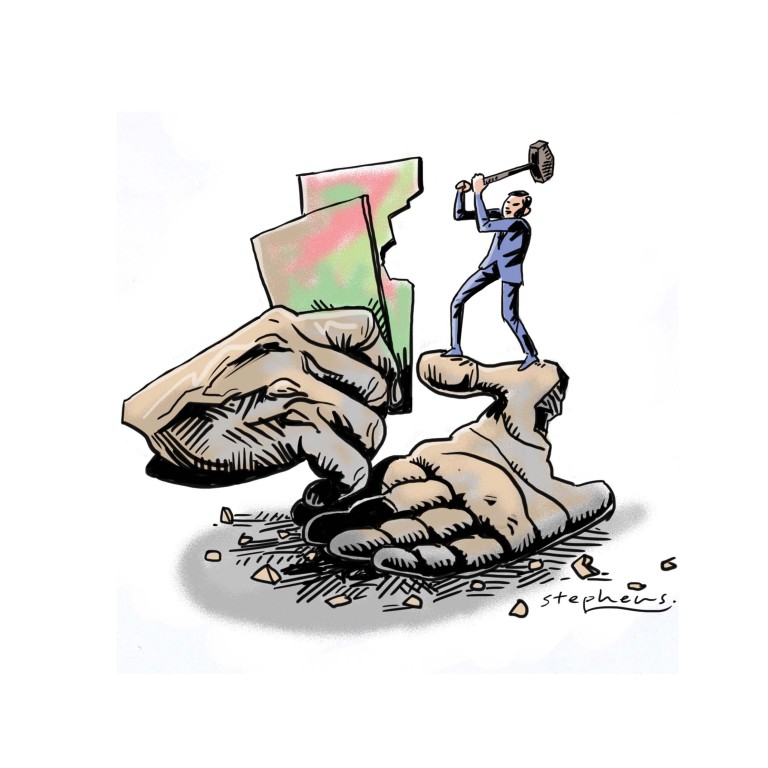
China must fight corruption, one city at a time
Winston Mok says systemic reforms that are needed to root out corruption will take time, and Beijing's efforts to strengthen the rule of law - in phases across the mainland - should be encouraged
Although China has embarked on the largest anti-corruption campaign in recent history, its corruption ranking by Transparency International has dropped significantly. At the same time, the World Economic Forum has continued to highlight corruption as a top, and rising, problem for doing business in China.
While the anti-corruption drive seems impressive, it also raises key issues. Why have some of the alleged perpetrators been allowed to go so far for so long? Are the current initiatives sufficiently comprehensive and even-handed? Are they sustainable if driven by a few motivated and capable leaders?
China's leaders well know the limitations of their current efforts. Anti-corruption tsar Wang Qishan noted early in his tenure that he was dealing with the symptoms while buying time to address the root causes of corruption.
Pervasive corruption has sprung from the architecture of the overall system. Thus, reforming the system of governance is the only effective way to control corruption. Systematic reforms, however, will take time. They may gradually unfold with the rule of law, as announced at the party's fourth plenum.
There is no mystery about how to control corruption. The least corrupt countries are those with the best rule of law. The top-ranking nations in Transparency International's index look very similar to those in the World Justice Project's on the rule of law. Asia's leaders of low corruption, Singapore, Japan and Hong Kong, all enjoy similarly high-ranked rule of law.
In controlling corruption through the rule of law, the key factors are civil justice, regulatory enforcement and constraints on government power. They happen to be among mainland China's weakest areas, according to the World Justice Project.
Decoupling the judicial system from local governments is a key step forward for civil justice. Central circuit courts will be set up; cross-regional courts may be in due course. Judges will become more professional, independent and accountable. All these moves should improve the independence of the judiciary, hitherto seen as the most corrupt part of the mainland state by the World Justice Project.
For regulatory enforcement, better rule of law will hopefully bring about greater respect for due process and property rights, and reduce improper influences.
Government power, constraints on or a lack thereof, has the highest bearing on corruption. The five countries with the lowest corruption levels also have the most constrained government powers. On the mainland, the high discretion of some local officials in the awarding of land and development projects may pose temptations too great to resist.
Due process in land sales and government procurement, through auctions and bidding, in large cities such as Shanghai could be more broadly and rigorously applied in smaller cities. Government approvals are being streamlined and compressed. The "No 1" party bosses in some regions such as Chongqing , Anhui and Shanxi will no longer be directly responsible for procurement or personnel matters. Leaders at the fourth plenum pledged to introduce more checks and balances within the government, as well as by the legislature and judiciary.
But the World Justice Project rated China the weakest on non-state checks on the government. The mainland's media and the internet have been powerful forces in exposing corruption. Recent clampdowns on media and internet freedom will not help. Leaving aside ideological and "sensitive" issues, the mainland's media should be given free rein to report on corruption - subject to the redress of libel lawsuits for slander.
In some ways, it may be unfair to compare a large and complex nation like China with smaller states like Denmark, New Zealand and Singapore. There is a wide spectrum of corruption across regions in China. If Shanghai (whose population is about the size of Denmark, New Zealand and Singapore combined), Beijing or Guangzhou were marked individually on corruption, they may well achieve more respectable ranks. Based on these three cities, the World Justice Project did indeed rank China higher, at 49th out of 99 countries and jurisdictions in 2014, as opposed to 76th overall.
China may consider developing its own municipal-level indices on corruption and rule of law - and apply them to cities, and perhaps later to counties. As Beijing broadens the evaluation of cadres beyond gross domestic product growth, such scores may take on increasing significance. Guangdong has experimented with such evaluations of clean governance for its cities and Guangzhou is starting a clean government index at the district level.
To reduce corruption, China needs to tackle its cities one at a time. At the top end, Shanghai and Guangzhou could compete with Hong Kong for the honour as the national standard-bearer of low corruption. For most mainland cities, a rank in the range from Malaysia to South Korea may be a more reachable goal. The key challenge remains bringing smaller cities inland to a minimum standard.
President Xi Jinping has set 2020 as the target date for the modernisation of governance. There is a ready indicator for the successful practice of the rule of law. Just look at China's ranking in corruption then.

